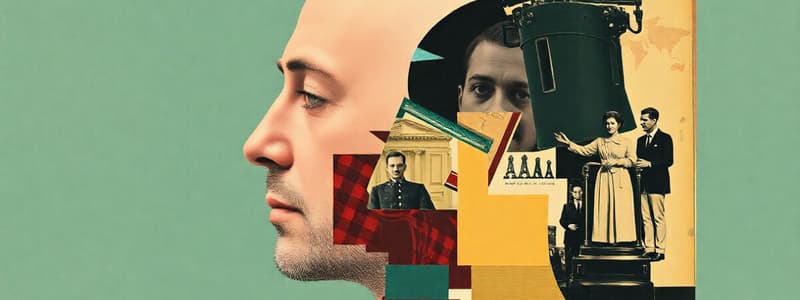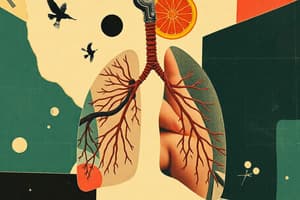Podcast
Questions and Answers
In the context of Fick's Law of Diffusion, what does 'X' represent?
In the context of Fick's Law of Diffusion, what does 'X' represent?
- The surface area available for diffusion.
- The diffusion coefficient of the gas.
- The difference in partial pressures of the gas.
- The thickness of the barrier across which diffusion occurs. (correct)
According to Fick's Law, if all other factors remain constant, selection would favor which of the following regarding 'X'?
According to Fick's Law, if all other factors remain constant, selection would favor which of the following regarding 'X'?
- Increasing 'X' to maximize diffusion.
- Decreasing 'X' to maximize the rate of diffusion. (correct)
- Maintaining 'X' at a constant level that neither increases nor decreases the rate of diffusion
- Decreasing 'X' to minimize the rate of diffusion.
According to Fick's Law, if all other factors remain constant, selection would favor which of the following regarding 'A' (surface area)?
According to Fick's Law, if all other factors remain constant, selection would favor which of the following regarding 'A' (surface area)?
- Increasing 'A' to increase the boundary layer.
- Increasing 'A' to maximize rate of diffusion. (correct)
- Reducing 'A' to minimize diffusion.
- Maintaining 'A' at a consistently low level.
What is a primary method by which animals increase the surface area ('A') for gas exchange, as mentioned in relation to breathing?
What is a primary method by which animals increase the surface area ('A') for gas exchange, as mentioned in relation to breathing?
Which of the following best describes the gas exchange mechanism observed in fish gills?
Which of the following best describes the gas exchange mechanism observed in fish gills?
According to provided notes, what is the approximate surface area ('A') of human lungs?
According to provided notes, what is the approximate surface area ('A') of human lungs?
What is the significance of countercurrent flow in fish gills for gas exchange efficiency?
What is the significance of countercurrent flow in fish gills for gas exchange efficiency?
Why might certain aquatic animals not utilize much oxygen?
Why might certain aquatic animals not utilize much oxygen?
What is the allometric exponent referring to in the context of the presented notes?
What is the allometric exponent referring to in the context of the presented notes?
What do external gills and internal gills have in common?
What do external gills and internal gills have in common?
In the context of gas exchange, what is the primary significance of countercurrent flow in fish gills?
In the context of gas exchange, what is the primary significance of countercurrent flow in fish gills?
Why are air-breathing mammals under less selective pressure to maximize the partial pressure difference ($P1 - P2$) during respiration compared to water-breathing fish?
Why are air-breathing mammals under less selective pressure to maximize the partial pressure difference ($P1 - P2$) during respiration compared to water-breathing fish?
In early lung ventilation mechanisms, such as those observed in some amphibians, what sequence of muscle action facilitates the entry of fresh air into the buccal cavity?
In early lung ventilation mechanisms, such as those observed in some amphibians, what sequence of muscle action facilitates the entry of fresh air into the buccal cavity?
How does airflow within the parabronchi of birds differ from that in mammalian lungs during gas exchange?
How does airflow within the parabronchi of birds differ from that in mammalian lungs during gas exchange?
Based on content 23.5, which statement accurately describes the selective pressure on birds’ gas exchange mechanisms?
Based on content 23.5, which statement accurately describes the selective pressure on birds’ gas exchange mechanisms?
Which of the following characteristics best describes the direction of blood flow relative to airflow in a bird’s parabronchus for gas exchange?
Which of the following characteristics best describes the direction of blood flow relative to airflow in a bird’s parabronchus for gas exchange?
What is the role of the posterior air sac in bird respiratory system?
What is the role of the posterior air sac in bird respiratory system?
During the initial stage of lung ventilation in some amphibians, fresh air is drawn to the buccal floor. What crucial event must happen immediately beforehand to make this happen?
During the initial stage of lung ventilation in some amphibians, fresh air is drawn to the buccal floor. What crucial event must happen immediately beforehand to make this happen?
Based on the content, what feature of bird ventilation most directly minimizes mixing of inhaled and exhaled air during gas exchange?
Based on the content, what feature of bird ventilation most directly minimizes mixing of inhaled and exhaled air during gas exchange?
Which structure is directly involved in gas exchange in birds?
Which structure is directly involved in gas exchange in birds?
Flashcards
Gas Exchange
Gas Exchange
The process by which animals obtain oxygen and release carbon dioxide from their bodies.
Partial Pressure Gradient
Partial Pressure Gradient
The difference in partial pressure of a gas between two areas, which drives the movement of gas molecules from a high pressure area to a low pressure area.
Diffusion
Diffusion
The movement of molecules from an area of high concentration to an area of low concentration.
Diffusion Coefficient (D)
Diffusion Coefficient (D)
Signup and view all the flashcards
Surface Area (A)
Surface Area (A)
Signup and view all the flashcards
Distance (X)
Distance (X)
Signup and view all the flashcards
Increased Surface Area for Gas Exchange
Increased Surface Area for Gas Exchange
Signup and view all the flashcards
Countercurrent Gas Exchange
Countercurrent Gas Exchange
Signup and view all the flashcards
Allometry of Metabolic Rate
Allometry of Metabolic Rate
Signup and view all the flashcards
Allometry
Allometry
Signup and view all the flashcards
Unidirectional Airflow in Birds
Unidirectional Airflow in Birds
Signup and view all the flashcards
Glottis
Glottis
Signup and view all the flashcards
Lung Ventilation
Lung Ventilation
Signup and view all the flashcards
P1-P2
P1-P2
Signup and view all the flashcards
Maximizing P1-P2
Maximizing P1-P2
Signup and view all the flashcards
Parabronchi
Parabronchi
Signup and view all the flashcards
Mammalian Ventilation
Mammalian Ventilation
Signup and view all the flashcards
Bird Ventilation
Bird Ventilation
Signup and view all the flashcards
Partial Pressure
Partial Pressure
Signup and view all the flashcards
Study Notes
Lecture 5: Gas Exchange
- Lecture date: January 15th
- Topic: Diffusion, maximizing Fick
- Reading assignments: Pages 644-651, Box 23, pages 629-639
- Review material: Pages 654-677
Strategies for Breathing Water
- Strategy 1: Organisms that don't use a lot of oxygen (O2).
- Metabolic rate (SMR) decreases as body mass increases. This is highlighted on a graph with relationships shown for different animal types. The relationship is different between these animal groupings.
Minimizing X
- X represents an anatomical factor in gas exchange processes.
- Natural selection may favour either increasing or decreasing X, based on mathematical contexts.
- Specific data found in figure 23.7 may provide further insights.
Metabolic Rates
- Comparison of metabolic rates (SMR) across different animal sizes and respiratory methods (air vs. water breathing)
- Two graphs are provided showing that both size and breathing method affect metabolic rate
Maximizing A
- A represents anatomical surface area in gas exchange
- Selection often favors increasing A
- Reasoning behind this preference often involves mathematical concepts
- Different strategies used by animals to increase A are presented
External Gills
- Describes anatomical structures of animals using external gill systems.
- Images show various types of external gills
Internal Gills
- Describes anatomical structures, including images for various invertebrates using internal gill systems
- The figures describe the arrangement of the gills from different species.
Lungs
- Discusses lungs utilized for gas exchange in various organisms.
How large is A?
- Surface area (A) for gas exchange is typically in the range of 30-50 square meters.
- A diagram shows the pathway of air and blood flow to alveoli in the lung to emphasize the extent of the surface area.
Allometry of A
- Investigates how surface area (A) for gas exchange scales with body size
- Demonstrates how different animal types show varying relationships of surface area to body size (allometric relationship).
Fish: Unidirectional Ventilation
- Explains the process of countercurrent gas exchange in fish gills
- Describes the direction of blood and water flow in fish gills, and emphasizes how it improves gas exchange efficiency.
- Diagrams show how water and blood flow in opposite directions in the gills.
Maximizing P1 - P2
- Describes the process of countercurrent gas exchange in gills, and why this is important
- Diagrams illustrate countercurrent flow and how this process increases the efficiency of exchanging gases.
Maximizing P1 – P2: Air Breathers
- Explains that a less selective pressure to maximize pressure difference in air-breathing creatures. The reason for this is discussed.
- The flow of air in mammals relative to blood flow is detailed, along with a diagram showing this.
Evolution of Lung Ventilation
- Shows an illustration with descriptive text on the evolution process of lung ventilation in amphibians.
Ventilation: Mammals
- Process of ventilation (breathing) in mammals
- Diagram demonstrates the expansion and contraction of the rib cage and diaphragm during inhalation and exhalation.
Bird Ventilation
- Details and diagrams regarding bird ventilation
Maximizing P₁ – P2: Birds
- Describes bird ventilation, focusing on unidirectional air flow inside the parabronchi where air capillaries are in contact with blood
- There is a discussion whether selective pressure increases efficiency.
Phylogenetic Tree of Reptiles
- Presents a phylogenetic tree and diagram of reptiles, showing insights into the evolution of the vertebrate respiratory system.
- The information includes the discovery of unidirectional airflow in iguana lungs.
Studying That Suits You
Use AI to generate personalized quizzes and flashcards to suit your learning preferences.


